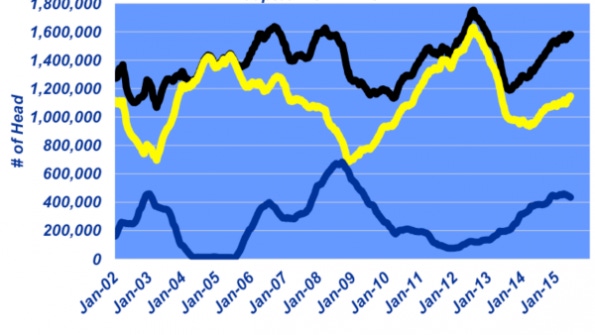Feeder cattle imports have long helped feedyards stay competitive.
June 25, 2015

Several weeks ago, Industry At A Glance featured the importance of beef trade with Canada and Mexico – specifically, the importance of the value of exporting beef products to our NAFTA partners. That discussion inherently draws attention to an additional component of trade with Canada and Mexico – namely, feeder cattle imports. This week’s illustration highlights some historical perspective of feeder cattle imports from the two countries.
U.S. feedyards have been fighting an uphill battle for many years with respect to diminishing domestic supply of feeder cattle. One means to help solve the enduring problem of excess capacity is to import feeder supply from Canada and Mexico. Imports of feeder cattle peaked in the summer of 2012 as Mexico was in the midst of a severe drought. That pace has declined over the past several years. However, imports are on the rise again with increasing numbers now arriving from Canada—much of that likely resulting from a strengthening U.S. dollar Perhaps most interesting in all this discussion is this: total feeder cattle imports have remained relatively steady and consistent over time. Despite factors such as drought and fluctuating foreign exchange values, total feeder cattle imports have consistently remained within a range of 1.2 to 1.6 million head on a 52-week rolling basis.
Perhaps most interesting in all this discussion is this: total feeder cattle imports have remained relatively steady and consistent over time. Despite factors such as drought and fluctuating foreign exchange values, total feeder cattle imports have consistently remained within a range of 1.2 to 1.6 million head on a 52-week rolling basis.
How do you perceive that level of equilibrium of feeder cattle imports? What’s your perception of the importance of feeder cattle imports from Canada and Mexico? How do you see them shaping the U.S. beef industry from a broader perspective? Leave your thoughts in the comments section below.
Nevil Speer is based in Bowling Green, Ky., and serves as vice president of U.S. operations for AgriClear, Inc. – a wholly-owned subsidiary of TMX Group Limited. The views and opinions of the author expressed herein do not necessarily state or reflect those of the TMX Group Limited and Natural Gas Exchange Inc.
You might also like:
60 stunning photos that showcase ranch work ethics
7 tools to win the war against cattle flies
Is agriculture the bad boy in the nation's water use?
Proper timing & products needed for deworming pasture cattle
21 ATV UTV and side-by-side units for 2015
About the Author(s)
You May Also Like





